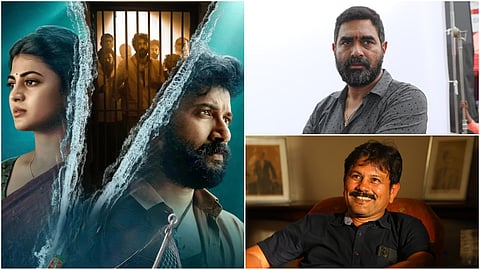‘Arabia Kadali captures humane and inhumane things on both sides'
In 2018, a group of fishermen from Andhra Pradesh were detained by Pakistani marines and forced to be in jail for nearly two years before they could be released. In a strange coincidence, Telugu filmgoers in 2025 had two filmmakers choosing this story as a canvas for their projects. While the Naga Chaitanya starrer Thandel captured the plight of these migrant fishermen in a formulaic three-act structure, Arabia Kadali, which premiered on August 8, attempts to explore the subject in greater detail, giving the larger-than-life story its due screentime.
In an exclusive conversation with CE, creator Krish Jagarlamudi and director VV Surya Kumar talk about how they crafted a coherent structure for a story like Arabia Kadali, the challenges in attaining visual grandeur for the series, and more.
Krish, what was the inspiration for developing the script for Arabia Kadali? What were the themes you wanted to explore?
Krish Jagarlamudi: When Chintakindi Srinivas Rao first told us the story, he said, ‘The sea is both a provider and a threat for these fishermen.’ He talked about how these fishermen, without knowing, crossed borders on waters, borders that don’t apply to fish or birds. Who drew those lines? That idea got me very excited, with this story of a long, tough journey of these fishermen from their village to Gujarat to Pakistan and then to the Wagah border.
How did Surya Kumar come on board?
KJ: Surya Kumar and I did many films together, where he worked as a co-director and handled second unit work on my films. Around the same time, he showed me some of his documentary short films. So I approached him with the idea of making Arabia Kadali as a series. Later, a writers’ room was founded, bringing Sri Kamal, Venkata Ramana Salwa, and others on board.
Surya, what was your first impression when you heard this story?
VV Surya Kumar: Since Arabia Kadali is based on real events, we decided to navigate this story through one singular character’s perspective; there’s a better hook that way — that’s how Badiri (Satyadev) came into place. Similarly, Ganga’s (Anandhi) character too has importance. At the same time, small characters have prominence as well. Survival drama is the main theme — the obstructions these fishermen faced, their conflicts, and the eventual journey had to be realistic. We were conscious about telling it dramatically without losing naturalism. That’s how many of these characters were born. We wanted to capture the lives of these fishermen realistically.
What are the challenges of adapting this story into a long-form structure?
KJ: When we would discuss the story in the writers’ room, the focus was on the narrative style, authenticity of the world, character sketches, and the themes. These fishermen would have their fights in villages, fight on the sea waters, and then continue to quarrel even after being caught. Eventually, their shared sorrows would unify them and make them reflect on their actions. The equation between Badiri and his father-in-law had a great transformation arc. In Arabia Kadali, as a long-form narrative, there was scope for going in-depth into characters, capturing their many shades. Surya elevated them very well.
What were the challenges on a production level, considering this show unfolds against multiple and varying backdrops?
SK: There was a lot of pre-planned work and detailing in advance, which the production was able to deliver. Cinematographer Sameer Reddy’s visuals really enhanced the grandeur. Similarly, our art director, D Siva Kamesh, used the design of Pakistani jails to create an authentic set. Even the costumes (by Aishwarya Rajeev and Rajasekara Reddy) were very integral to the look and feel. Every technician really supported me, which is why we could achieve the grand scale.
KJ: When it comes to grandeur, the screen size doesn’t matter. There was a similar story in Thandel, which is now a series. The story demanded such extensive work — we can’t avoid that. The team shot from 5.30am to 9pm, throughout the outdoor schedule. This is clearly 100 days’ work, but the team wrapped it up in 55 days. Like for the sequences set at sea, Sameer Reddy and Surya would set everything up by 5am and wait for natural light. You can only set up so much artificial lighting while shooting at sea.
The outdoor shoot must have been particularly challenging…
SK: We shot outdoor location scenes for 30 days, starting in June, the rainy season. But we managed to wrap the shoot without any weather hassles. And it happened many times that right after we packed up, it would start raining. God helped us that way (laughs).
Which was the most challenging character to create?
KJ: For me, Ganga is an emotion; she represents purity and wildness at once. We named her so because she is like a flowing river. Even when the fishermen return, we see on Ganga’s face a small fear too, besides joy. Badiri and Ganga share very few scenes together, so it was important to capture the trust they had in each other, their unexpressed feelings towards each other. Even the initial boat journey scenes, with all the interpersonal dynamics between the fishermen, came out very well.
Krish, how was your involvement as a showrunner?
KJ: Surya was the captain of the ship, while I was more of a guardian, a guide whenever required. In a longer format, one has to be careful about narrative continuity, making sure that arcs are established early. For every episode, we went through multiple readings to ensure we had enough cliffhangers and hooks. It was a hard task, but essential for the series.
The balanced portrayal of Pakistani officials was very refreshing…
KJ: Once these fishermen are caught, they become political entities. The Pakistani officials are guarding the prisons, but they also have latent, preconditioned anger against fishermen. Once they realise the prisoners are nice human beings, it’s a beautiful feeling. There are parallels between the rivalry of two villages to that between two countries, and on both sides, there are great human beings and bad ones as well.
The character writing for Pakistani officials was not done arbitrarily. We did a lot of research, watched documentaries, and spoke to prisoners to ensure that it was realistic. While some treated the prisoners badly, there were helpful people as well. The same applies in India. Like when the judge points out how these are ordinary fishermen, merely stuck in geopolitical issues. Our story is about these people, and the aim was to capture both humane and inhumane things on both sides.


